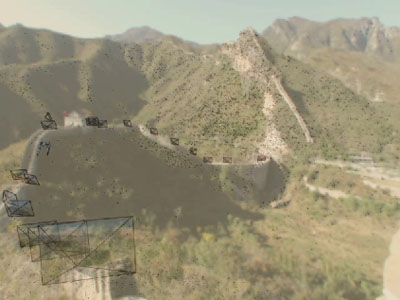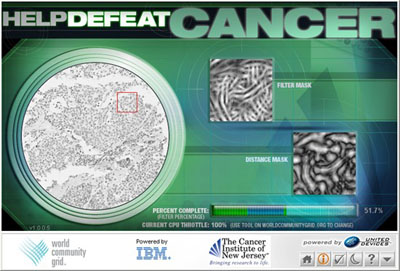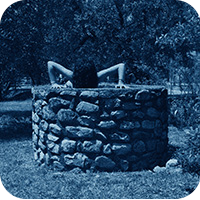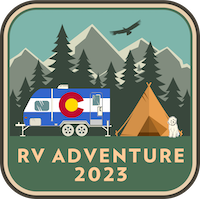Ore consequences
My parents recently built a second home in Galena, IL. Galena is in the far northwest corner of the state, nestled between Iowa and Wisconsin. It was a major river town in the 19th century, home to Ulysses Grant and a slew of other Union generals. But the river silted up, Chicago grew up, and Galena slumbered away. Now it is basically a quaint time capsule catering to Chicago weekend escapees, the kitschy knick-knack obsessed, and Civil War buffs.
Galena is the word for lead sulfide, veins of which criss-cross the area. As luck would have it, my parents’ land has an abandoned lead mine on it. This isn’t suburbia; the lots have (fantastically) reverted to native Illinois prairie. But it was once farmland and apparently the owners way back found a small lode and went for it. The builders of my parents’ home wanted to fill the mine entrance in with excavated soil and landscape it. My father, to his infinite credit, said screw that I want a lead mine on my property. And this brings us to today when I had to enter and see what there was to see.
I’ll preface this by saying that my adventure was not formally approved by the family. My boys of course were right there with me but mama’s look of disapproval, had it been cast groundward, could have dug its own mine.
I struggle to list a hazard that this mine doesn’t contain so in the interest of having something to blog about I’ll here detail those that it does. The mine is completely structurally unsound, having been abandoned more than a century ago. The whole reason for digging it in the first place is because it contains lead, the very substance that causes parents to obsess about our kids eating paint. It is wildly overgrown and so home to all manner of critters, vermin, and poison flora. There are tons of snakes in these parts and my dad mentioned that he saw something “dog-sized” leaving the shaft yesterday morning. Hmmm, lovely.
So I went in. The kids, standing at the rim of the depression that led to the shaft, were nearly apoplectic with excitement. And while we’re using apoplexy as a metaphor I’ll mention that it also described my wife at this moment, but for very different reasons.

The shaft entrance had long ago been filled in. Metal containers of all varieties, a tire, and barbed wire clogged the hole. I struggled to loose them but the entrance was a garbage pit. Every time I unearthed a rusty shard I expected some venomous slitherer to inform me of its displeasure. A wooden beam — really a crudely shaped log — lay uphill from me in the overgrowth and seemed to mark the entrance to the shaft. My father, lost to me but for yelling, agreed that the best plan was to wait for fall when the foliage died off and then resume digging. Actually he wants to rent a ground radar to see what we’re up against. He thinks he’s identified a second entrance (exit?) nearby.
In the end this is just good fun. How many kids grow up with an abandoned lead mine as a playlot? Too few, I say.
Victory and fear
James Fallows has an good piece in this month’s Atlantic Monthly (teaser only online to non-subscribers, alas). Yesterday’s events in the UK make it a great piece.
Fallows argues that the “war” on terror should be declared over because of the successes the US and its allies have had (dispersing al-Qaeda, foiling plots, etc) but mostly because calling this protracted struggle a war plays right into terrorists’ hands.
Perhaps worst of all, an open-ended war is an open-ended invitation to defeat. Sometime there will be more bombings, shootings, poisonings, and other disruptions in the United States. They will happen in the future because they have happened in the past (Oklahoma City; the Unabomber; the Tylenol poisonings; the Washington, D.C.-area snipers; the still-unsolved anthrax mailings; the countless shootings at schools; and so on). These previous episodes were not caused by Islamic extremists; future ones may well be. In all cases they represent a failure of the government to protect its people. But if they occur while the war is still on, they are enemy “victories,” not misfortunes of the sort that great nations suffer. They are also powerful provocations to another round of hasty reactions.
Hasty reactions. A good tagline for what will surely ensue after yesterday’s anti-terrorism victory. Boing Boing chronicles the new idiocy:
Check out this article from Asheville, NC. “Maya Leoni, who is held by Angela Perez, cries as her mother, A.J. Leoni, pours the last of her drink into the receptacle while in line for the security checkpoint at the Asheville Regional Airport.”
POUR IT INTO A RECEPTACLE? Don’t you think that some of these potentially explosive liquids might be more dangerous when, I don’t know, mixed in a big vat in the middle of an airport?
Christ, why don’t they just have people put their liquids into a big bonfire?
If we overreact to this plot — tremble, retrench, withdraw, not think — it will be little better than if the bombs had gone off.
Snackposts
To tide you over until the next meal.
Voting on panels for next year’s South by Southwest Interactive conference is open. Remember this is purely a popularity contest and that I will send you a postcard from Austin if you vote for my panel. (Note that the list of available panels randomizes itself on load to prevent giving precedence to those near the top. Lovely!)
The woman who cuts my hair has no e-mail address. She can only be contacted via MySpace. Now, I don’t profess to understand what the hell is going on at MySpace, but this seems a bit extreme no? Also, the name she uses in the salon isn’t her real name. The salon gives hairdressers fake names to ensure that they are mutually distinct enough not to be confused over the phone during appointment-making. Persona in MySpace; persona at work.
Propelled by Digg and del.icio.us, the LEGO mosaic post was shooting all over the ‘tubes last week. Off to the bandwidth races!
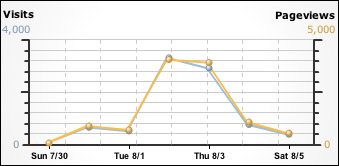
During this deluge Holly posted a link to a similar project of hers, effectively puncturing a hole in the bottom of the tub and flooding her site too. And what a site it is. Cracks me up. Hollyrhea: highly recommended.
Books that, when released, I’ll dump what I am reading at the time for: The Echo Maker, by Richard Powers and The Ghost Map, by Steven Johnson. (Oh, anybody know what Neal Stephenson is up to?)
And lastly, to the terminally dorky I ask: Why is there no way to convert an RSS feed to a webcal feed? C’mon people.
Shoehack, day one: criminal apprehended
So I’m running with my newly-technologized shoes yesterday. As I cross a busy street I see a cab going way too fast in the center turn lane.* It suddenly turns hard right, slams full speed into a Jeep Cherokee headed the other way, and throws it up onto the sidewalk and a parking meter. Me and another guy running on the opposite side of the street immediately sprint for the collision. As we get to the cab the driver’s door opens and out falls a little kid, maybe 10 years old. He hits the deck, bleeding from his mouth, and then gets up and runs. So we run after him. I don’t exactly know why, but it seemed like he shouldn’t just run off. It was only when we had tackled him back to the pavement that it occured to us that this kid had just stolen a cab and taken it for a joyride.
He lay on the sidewalk, spitting blood, and moaning not to turn him in. I guess I’ve watched too many Cops episodes because the first thing I asked was “Do you have any weapons or needles on you?” He didn’t respond. I asked him if his face hit the steering wheel and he said yes. The police came, quickly. The elderly driver of the Cherokee was pinned in and covered in glass, but he seemed to be OK. It is amazing to me that pedestrians were not hit. That section of the street has very broad sidewalks that are heavily trafficked. The cab would have thrown pedestrians straight through the plate glass of the bank building there.
Clearly my robo-shoes have transformed me into a crime-fighting superhero. This is the only explanation. Who knows what dastardly deeds I will foil on my next run.
[*] Ashland Ave. just north of Belmont for Chicagoans wanting coords.
Nike plus iPod minus Nike
Have you seen the new doodad from Nike and Apple? The receiver that you hook onto the iPod nano and the transmitting pedometer that you put in your shoe? It looks perfect. It’ll track my runs (even indoors — take that, GPS!) and then synch it all online when I dock the iPod. Perfect.
Except, wait. I have to buy new shoes that fit the pedometer? And they have to be Nike running shoes? But I hate Nike running shoes. I think most people hate Nike running shoes. Well, this sucks. It’s like … Nike is locking people in to proprietary hardware just like … Apple. Hmm, making more sense now.
The Intertubes of course offer a few solutions to this. Some people are velcroing the pedometer under their laces. Others are just sticking it in a little lace-attached pouch.
All fine shoehacks, but I thought I could do one better. See, I have flat feet — Kansas flat feet — so I run with orthotic inserts. Turns out they are almost exactly the right depth to fit the little pedometer, if properly cored out. Note that this might work with the regular inserts in shoes. Orthotic inserts are not that much deeper than the factory inserts. Try it.
Remove the insert.
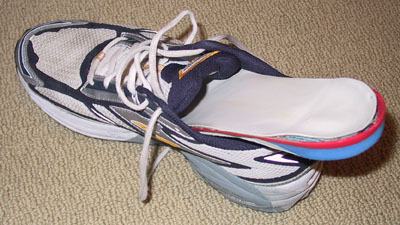
Grab a power tool for shaving off the hard plastic. Make the hole a little smaller than you need.
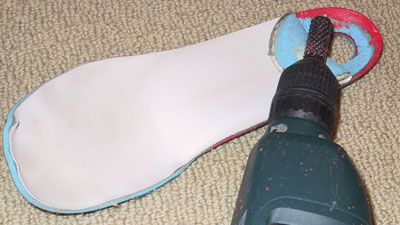
Pop it in.
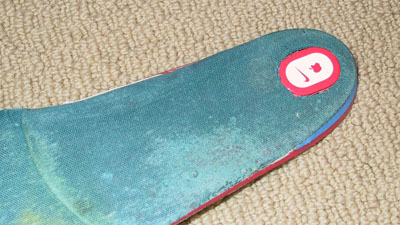
Behold your new cyborg shoe.
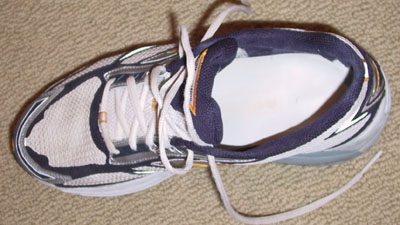
Building a virtual world one tourist photo at a time
The phrase “Hey, wanna see my vacation photos?” has stricken fear into the hearts of co-workers and family members since photography was invented. But the combined mass of pics could help build virtual worlds of, well, of the whole photographed world. The University of Washington and Microsoft (believe it or not) have created a jawdropping demo of stitching together disparate photos of the same place into a textured navigable world.
The site is called Photo Tourism, but that doesn’t do justice to what these people have done. Only the videos convey the concept.
Soon enough this will be integrated with Google Earth and its ilk. A virtually navigable earth at all levels of detail can’t be that far off.
Of course, most tourist photos contain people in them. But that appears not to be such a problem either. Witness Tourist Remover. (Oh, to have this in real life.)
Ohm sweet monome
I’ve had the extraordinary luck* to get my hands on a monome, the amazing USB controller that’ll do just about anything you want it to. The monome is an 8×8 grid of sturdy backlit buttons. And that’s really about it, functionally. It interfaces with a slew of music apps that turn it into a keyboard, a sequencer, a ribbon slide, or just about any tactile way you can imagine to control sound. And the design! If it weren’t so sturdy I’d call it cute. Form and function, as one.
I spent a great evening playing with the monome last night.
[*] Luck being a friend who has loaned it to me for the month while he gets married and honeymoons, presumably because he was forbidden from taking it with him. The first sign of doomed marriage, if you ask me.
Demolishin’
Almost exactly two years ago I had a true bonding experience with my son watching a garbage truck in front of our house dump its whole load on the street to try to figure out what piece of trash inside it was on fire. Garbage men, policemen, firefighters, and a bulldozer: does it get any better than that?
Well, apparently it does. I have just learned that the small town in northwestern Illinois where my parents have a home is host to — wait for it — a demolition derby using farm combines. Let me apply some formatting to that: a demolition derby using farm combines. And not just any combines but decrepit, rusty-blade-whirling junkers ready to be auctioned off as scrap. Forget summer in the city. I want to see this rural answer to robot wars. Can you imagine the carnage? How onlookers don’t get pierced with shrapnel I have no idea. I am willing to risk it.
Hack your children
Yesterday Parent Hacks featured my post on how to create a LEGO mosaic manually (or mostly manually). Asha Dornfest has created a really wondeful site applying the hacker mentality to parenting. The site has exploded in popularity, presumably because geeks can reproduce and even take an interest in what they spawn.
Parenting as a community of interest on the Internet has grown immensely in recent years (or maybe I am just paying better attention). Federated Media just created a metablog that combines parenting-related posts from many of their major properties.
In addition to straight tips and tricks, Baby Roadies and The Sneeze provide some hilarious dad perspectives on the parenting arts.
Birthin’, surfin’ … a perfect match. I mean, they’re both just a series of tubes.
World Community Grid takes on cancer, take two
Not sure what happened to this post. It literally just disappeared. (Has anyone ever experienced a spontaneous Movable Type database reversion?)
Anywhere, here it is again. I’ve typed extra hard to make sure it sticks.
The World Community Grid has just launched its third program to fight disease using the combined computing power of desktop machines across the world. Like prior programs (which continue to run!) Help Defeat Cancer stitches together idle processing cycles to crack the nut of cancer tissue microarray analysis, a step towards enhanced treatment.
Oh, WCG also has Linux and Mac clients now. (They ain’t pretty, but then neither is data-crunching, frankly.)

